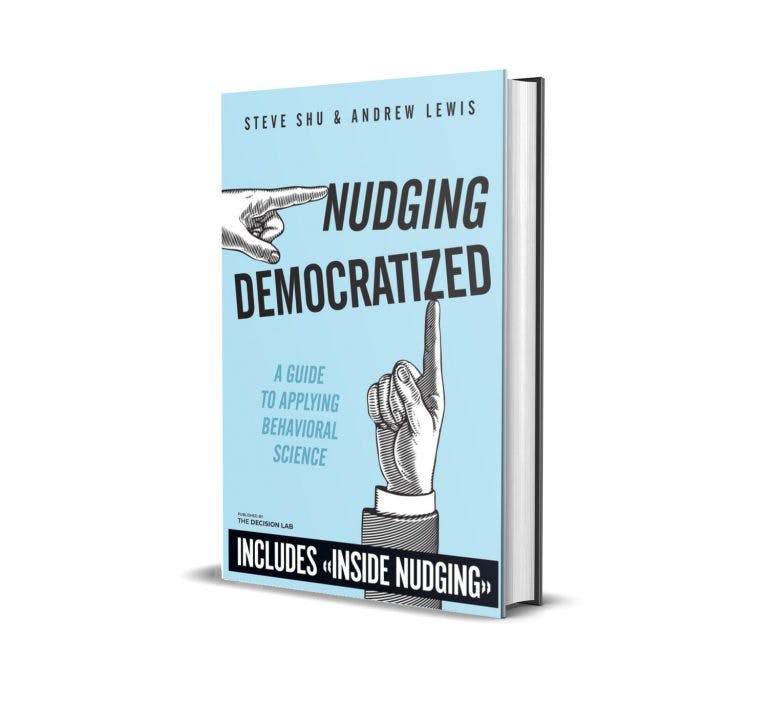Nudging, Democratized: A Guide to Applying Behavioral Science

From New York Times bestselling titles to Nobel Prize-winning research, the past decade has been transformative for behavioral science. What was once a mostly academic movement on the fringes of economics and psychology is today a field that fuels government, industry, and philanthropic work at the highest levels. There’s a reason for this quick ascent: unlike many other academic disciplines, research into human behavior has yielded insights that are digestible, and often intuitive, to non-specialists — and can help us inform and improve decisions in both our personal and professional lives.
Spreading these insights to a broader audience has been at the core of our mission since founding The Decision Lab in 2013. It is our firm belief that knowledge should be an equitably distributed resource — and that we should all learn about the forces shaping our behavior. To realize this goal, we aim to publish authors who can use everyday experiences and language to translate complexity into common sense, and make it interesting, too. Each of our articles has a simple formula: take a lesson or two from peer-reviewed behavioral research and explain it in a way that an unfamiliar reader can find not just understandable, but useful. Over the years, we’ve taken to calling this effort democratization — or simply, spreading information beyond its traditional boundaries and audiences.
As we’ve grown, it is in this spirit we’ve begun providing consulting work for organizations in need of behavioral and experimental expertise. These projects are driven by the belief that all organizations can benefit from understanding the behavior of their constituents or clients, their leaders or laborers. At its core, behavioral science is just a way for organizations to think critically about how their actions (e.g., marketing strategy or store layout) affect behaviors they are interested in (e.g., purchases or program enrollments), and to test the efficacy of different approaches empirically. We know that small tweaks in our environments can have large, consequential effects on our actions, and as such no organization is too small to incorporate behavioral insights into its operations.
As we’ve grown, it is in this spirit we’ve begun providing consulting work for organizations in need of behavioral and experimental expertise. These projects are driven by the belief that all organizations can benefit from understanding the behavior of their constituents or clients, their leaders or laborers. At its core, behavioral science is just a way for organizations to think critically about how their actions (e.g., marketing strategy or store layout) affect behaviors they are interested in (e.g., purchases or program enrollments), and to test the efficacy of different approaches empirically. We know that small tweaks in our environments can have large, consequential effects on our actions, and as such no organization is too small to incorporate behavioral insights into its operations.
It is with these goals in mind that we are thrilled to announce the release of Nudging Democratized: A Guide to Applying Behavioral Science. The book, co-authored by the brilliant Steve Shu and TDL editor-in-chief Andrew Lewis, provides a practical blueprint for organizations to start using behavioral science at low-cost and with relative ease. Aggregating lessons from his three-decade career as a management consultant, Shu provides a framework of application that will empower businesses of any size to benefit from the principles of behavioral science and human-centered design.
The book’s main contribution is in spelling out the process of Behavioral GRIT TM, which stands for business functions related to Goals, Research, Innovation, and Testing. By setting these priorities ex-ante, Shu marshals examples of how organizations have integrated behavioral science into their business practices, including the incubation of innovation centers and development of behavioral science overlay capabilities. Throughout the book, case studies provide a view of how real organizations have incorporated behavioral insights to achieve a wide range of desired outcomes. For each case study, Shu highlights an element of the GRIT framework to give the reader hands-on examples of its implementation. For Goals, we see a large financial services firm implement an in-house nudge unit to create and encourage behaviorally-healthy retirement plans. For Research, Shu explains the impetus for and practice of incorporating behavioral and experimental research into business practices — a concept he concedes is likely somewhat foreign to the average manager. In explaining Innovation, Shu walks the reader through a private company’s experience of designing an app that leverages behavioral insights to encourage individuals to think holistically about life planning. In the section on Testing, we see the evaluation of a successful effort to reframe information and nudge individuals from different income groups to save money.
Taken together, Shu’s recollections of past work with businesses of diverse size and purpose offers a rich narrative on the flexibility and practicality of applied behavioral science. The purpose of the book — in line with our efforts toward democratization — is to lower the barriers to entry, and provide managers with a toolkit for making use of behavioral insights in their organizations. For any reader uncertain of how they might translate broad behavioral concepts into actionable business strategies — or for any aspiring behavioral scientist seeking a glimpse into the types of problems and solutions they might expect to face in the field — this book is the place to begin. Pick up your copy here, and let us know what you think!
Behavioral Science, Democratized
We make 35,000 decisions each day, often in environments that aren’t conducive to making sound choices.
At TDL, we work with organizations in the public and private sectors—from new startups, to governments, to established players like the Gates Foundation—to debias decision-making and create better outcomes for everyone.
About the Author
Andrew Lewis
Andrew is a writer and behavioral scientist focused on belief construction and how people evaluate new information. He is a PhD candidate in Politics at the University of Oxford, and a doctoral researcher at its Centre for Experimental Social Science (CESS). He was previously at Carnegie Mellon University where he worked at the BEDR Policy Lab and Center for Behavioral and Decision Research (CBDR), and was a research and teaching assistant to George Loewenstein.





